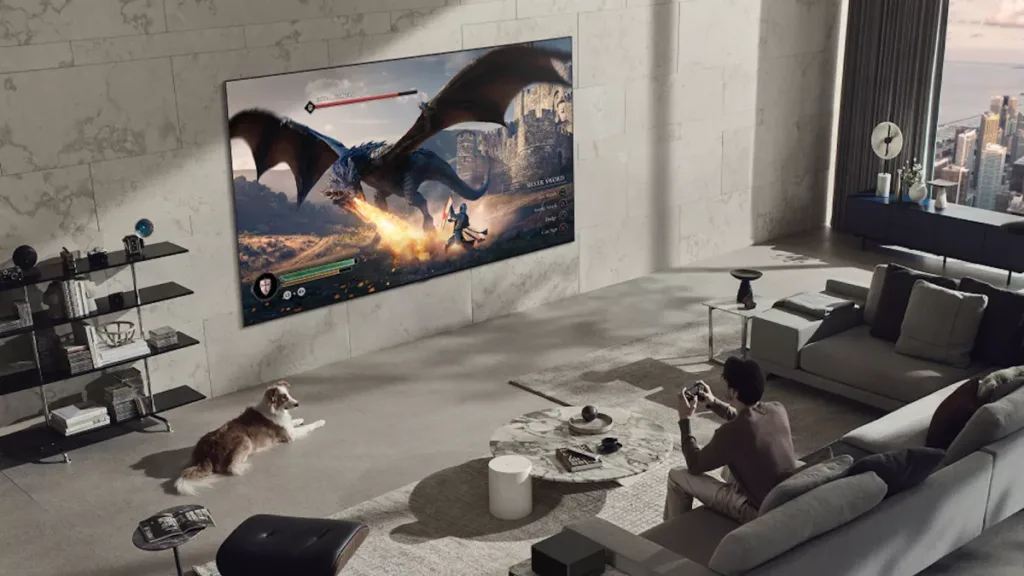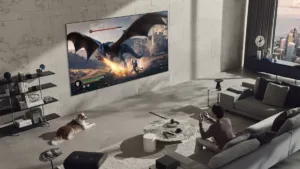I was interested to see the news of the LG wireless OLED TV that was shown recently at the CES 2023 show as a novelty. However, the idea is not a new one.

The set still needs a wired power connection, but all the audio and video signals between the control unit and the display panel are wireless. The set is just a 4K device, but as I recently wrote for the 8K Association (Why 8K OLEDs and QD-OLEDs are So Difficult to Make), it’s really, really difficult to make 8K OLEDs. It’s also really difficult to make 97″ sets, so making 97″ 8K sets is doubly difficult.
Not a New Topic
More than a decade ago, companies were very interested in making wireless TVs using very (very) high frequency wireless signals at around 60GHz. You need very high frequencies at this point in the signal chain as the data for the display has been decompressed from the original signal coming into the set. At 120Hz, and uncompressed, a 4K 10 bit HDR signal is 30 Gbps which is a lot of data, so you need a lot of bandwidth in the transmission. Even in the earlier attempts to develop wireless technologies, with 8bit FullHD, there was a need for around 3Gbps.
Back in May 2009, I wrote an article in Display Monitor about efforts to standardise 60GHz technology under the WiGig name. The technology was originally claimed to be able to support 6Gbps which was enough for FullHD. The technology was competing with a number of other technologies for wireless display support but at CES in 2013, it was announced that WiGig would be absorbed into the WiFi Alliance and that was, effectively, game over for the competition.
The Challenge of 60GHz
The challenge with signals at this kind of frequency is that they start to act more and more like light. If you get in the way of light you block the light and create a shadow. The earlier 60GHz systems had a similar problem. Simply walking between the transmitter and the receiver could block the signal at least partially. That was not great if you wanted the TV buyer to be able to put the controller anywhere in a living space. That’s the kind of problem that is also challenging Wi-Fi and other wireless.
The way that this kind of problem has been addressed by engineers is by using a technology called MIMO or Multi-Input, Multi-Output which uses an array of different transmitters and receivers at each end of the transmission to allow different signal paths to give some level of redundancy if one direct path is blocked. It gets complicated as the signals need to be split and recombined at each end, but the system works and has been one of the key technologies behind the development of recent Wi-Fi and 5G wireless standards.

I’m assuming that LG is using the same kind of MIMO technology in its 97″ as supporting chips will be much more available than they were last time this concept was tried. The fact that the WiGig technology has effectively become part of the Wi-Fi specifications meant that the scale of the business has made the cost of the technology accessible. One of the key technology companies that developed WiGig, Wilocity, was acquired by Qualcomm in 2014.
The Other Problem of Wireless
At the time that the developments of the idea of wireless displays was going on, the idea of wireless monitors was developed. Wouldn’t it be great if you could just put down your notebook next to the monitor and not have to worry about a cable? The disadvantages of 60GHz in terms of blocked signals were unlikely to be a problem, and the relatively short range of 60GHz was actually a potential advantage as it reduced the security risk that someone could scrape data off a display by intercepting the wireless signal.
However, there was a snag. Although many companies demonstrated ways of charging notebooks using wireless techniques, the concept didn’t take off. As a result, the notebook needed to be plugged in to a power supply. Put the power supply in the monitor and using USB-Type C you could deliver power and the video data using a single calbe, so there was no need for wireless.
The same problem applies to wireless TVs. If you have to get power to the display unit, that means wires. The same wire (or conduit) can be used to deliver the audio and video if you use copper. Fibre is a nicer way to get the data signal to the set and has been used by Samsung in some of its ‘two box’ TVs, but then you need to get power to the display some other way.
Either way, the downside of using wireless is that it adds some cost and complication, but if it doesn’t completely replace the cable. Worse, it really brings no additional performance or features to the user. Given that the 97″ LG OLED TV is going to be very expensive anyway, that’s not an issue for the LG set, but that will remain a challenge for the wider adoption of wireless TV.
Bob Raikes is an very experienced writer on the display industry. As well as writing for Display Daily, he writes for the 8K Association and for Information Display.

